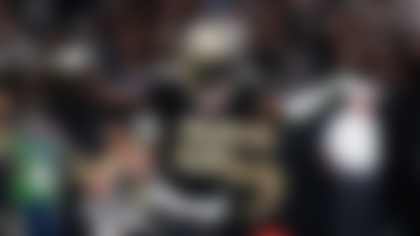Santonio Holmes' iconic catch in Super Bowl XLIII, the one you've seen many times, came on second-and-goal from the Arizona Cardinals' six. Pittsburgh was down a field goal.
Backdrop is as important as anything when determining the top plays of the decade. And so as I built the top plays of the 2000s for "Decades Month" on NFL Network, I couldn't escape these facts on Roethlisberger-to-Holmes, no matter how much people remember that catch.
Put another way: Dwight Clark's grab in the '81 NFC Championship -- "The Catch" -- came on third down with the Niners down six. Big, BIG, difference.
Was Holmes' play spectacular? Sure. Did it help win the game? You bet. So was it the greatest play of that Super Bowl? Doubtful. James Harrison's insane 100-yard interception return at the end of the first half was a helluva deal. Essentially, those two plays feel like two guys who hit 40 home runs on the same team, then cannibalize each other's MVP worthiness.
That said, another play from this era of Steelers football makes the grade, while Holmes' catch, Harrison's rumble, T.O.'s sharpie, Romo's bobble, and any other play from 2000 to 2009 fall just shy.
So without further ado ...
5) Big Ben's one-handed tackle
It has become common knowledge over the last few years that the hot team, not necessarily the best team, wins the Super Bowl. No ball club exemplified that Y2K axiom more than the 2005 Pittsburgh Steelers.
Going into Week 14, Pittsburgh was 7-5 and hanging on to a string to get into the playoffs. It was going to take 11 wins to make it into the postseason tournament. So what did Bill Cowher's Steelers do? Win out, of course. Then they proved they belonged in the postseason, taking down the Cincinnati Bengals and quarterback Carson Palmer (thank you, Kimo von Oelhoffen) in the opening round.
The divisional playoffs were a different matter entirely, as their opponents were the favorite to win it all.
Not much slowed the Indianapolis Colts, who started 13-0 en route to earning the AFC's top seed, that year. The Steelers would have to stop two-time defending MVP Peyton Manning, as well as his 1,000-yard receivers: Marvin Harrison and Reggie Wayne.
For most of that mid-January afternoon, Dick LeBeau's defensive unit did just that, harassing Manning repeatedly while the Pittsburgh offense used timely passes to build a 21-3 second-half lead. That's when the Manning-led Colts came roaring back, scoring 15 unanswered points in the fourth quarter.
With the ball on their own 12-yard line and 1:27 left in the game, Indy went for it on fourth down, only to see Manning get sacked back at the 2. The Steelers merely needed to punch it in to clinch this sucker. So they went to the hammer, Jerome Bettis, who proceeded to get hammered by linebacker Gary Brackett. The ball bounced around, ultimately settling into the waiting arms of cornerback Nick Harper.
This was it. The Colts were going to avoid the upset. Harper was home free, with a convoy in tow and only one man to beat -- Roethlisberger. Harper cut to his left, forcing the tall Steelers quarterback to contort his body in an attempt to make a one-armed tackle with his right hand. ... The effort would be just enough, as Big Ben tripped up Harper at the last second. The Colts still had the ball, but kicker Mike Vanderjagt missed a game-tying field-goal attempt.
Three weeks later, the Steelers won Super Bowl XL. This hot team not only won it all but proved to have the hot hand -- literally.
4) Junk(in) ball
Three years before the Colts' comeback fell short against the Steelers, the San Francisco 49ers put on a great comeback of their own in the 2002 NFC Wild Card Game. Except what fell short this time was a Giants field-goal snap, not San Francisco's rally.
The seventh postseason meeting between the Giants and 49ers was more of a meet-and-greet than a contest most of the day, as Jim Fassel's team was blowing out San Francisco on the road, 38-14, with 20 minutes to go. This was when Jeff Garcia went nuts. Steve Young's heir to the throne completed a 26-yard touchdown pass to Terrell Owens, ran 14 yards himself for another score, led the 49ers on a field-goal drive and hit Tai Streets (remember that guy?) for another 13-yard score to put San Francisco ahead, 39-38 ... all in a 14-minute span.
Then things got weird.
Kerry Collins took advantage of solid field position to maneuver the Giants into San Francisco territory, setting up a Matt Bryant field-goal attempt from the 23. Trey Junkin, a 41-year-old veteran who wasn't even in the league one week earlier, was the snapper. Unfortunately for Junkin -- long one of the finest at the position in pro football -- his snap was a wobbler that forced holder Matt Allen to improvise. Allen broke to his right, holding the ball as if to signal to his teammates to head downfield and get open. After scrambling a few yards, Allen hurled a pass to lineman Rich Seubert, who was dragged down as the ball was coming toward him ... a CLEAR pass-interference penalty if there ever was one.
One problem: The officials threw a flag on Seubert for being an illegal man downfield (the wrong call). Just like that, one of the most exciting playoff games in decades, and biggest comebacks in postseason history, came to a seriously controversial close.
The play has haunted Junkin for years. Anybody who saw it will never forget it.
3) "He did what!?"
On an October night at Lambeau Field 14 years ago, Antonio Freeman produced the most incredible ending to a prime time game ever.
After being a powerhouse for most of the '90s, the 2000 Packers found themselves at 3-5 and in danger of not even having a shot at making the playoffs. Meanwhile, their opponents were the Vikings, who at 7-1 were hanging with "The Greatest Show on Turf" in the race for home-field advantage.
You know how things can go on Monday Night Football, though -- the Cheeseheads gave Dennis Green's team all it could handle. While Green Bay would be outgained in this NFC Central battle (before the NFC North days), the defense forced five turnovers to keep Brett Favre and the offense in the game. Tied at 20 late in the fourth quarter, pouring rain and a poor snap led to a botched Minnesota field-goal attempt, sending the game into overtime. That's when some Monday Night craziness happened.
On the first drive in the extra period, Favre moved the Packers down to the Vikings' 43. On third-and-4, the Vikings blitzed, forcing the three-time MVP to send a quick lob to Antonio Freeman. Vikings corner Chris Dishman was stride for stride with Freeman in coverage, and managed to bat the ball down ... just not down enough.
Freeman, who had lunged for the pass, was falling to the ground when the ball hit the back of his left shoulder. Turning his body, he was able to tip the ball up with his right hand while bouncing it off his left forearm ... before securing it up against his pads. Freeman got to his feet, made a hard cut to his left to avoid the safety, then trotted the last 10 yards for the game-winning touchdown.
"He did WHAT!?" bellowed Al Michaels on the ABC broadcast, perfectly describing what we were all thinking.
2) The Helmet Catch
You can't label the miraculous grab David Tyree made in Super Bowl XLII as anything else, as "The Catch" is the property of Dwight Clark and, of course, our top play of the 1980s.
And yet, the play Tyree made to save the Giants' championship dream might be the No. 1 play in Super Bowl history.
Big Blue's opponent, the undefeated Patriots, had gone 16-0 in the regular season -- the first team to ever do so -- then proceeded to win both of their playoff games. New York gave New England all it could handle in Week 17, despite ultimately falling in a Saturday-night thriller.
On this day in February, however, the underdog Giants would not go down.
So it's with that as the backdrop that a little-known receiver out of Syracuse -- and his helmet -- came up HUGE. With merely 1:15 to play, and trailing 14-10, Giants quarterback Eli Manning had to make a play of his own. It was third-and-5, with the ball at the Giants' 44.
Operating out of the shotgun, Manning's pocket collapsed and Jarvis Green got a paw inside the QB's collar. But Manning did not go down. Instead, he freed himself, stepped right, then unleashed an ominous throw to all those who wanted to see the '72 Dolphins eat it.
It was a throw that was ... late, high and over the middle.
Call that the cardinal sin of a quarterback in charge of winning a game. Except this time it worked. Tyree leaped for the floater, trapping the ball between his hand and helmet, while shielding enough of his body from safety Rodney Harrison's disruption.
Forgotten in all this to fans was the fact that Tyree had caught a touchdown earlier in the game. Not lost on Manning was the fact his miracle receiver was unable to catch anything in the Friday practice before the Super Bowl. Hey, that's football. Good stuff.
1) The Tuck Rule
Of course, it should be noted that those Patriots might have never developed into a dynasty capable of going 16-0, or 18-1, had it not been for one fateful play in Foxborough, Massachusetts, in January 2002.
The out-of-nowhere Patriots, led by a relative nobody in Tom Brady, were squaring off against a very talented Raiders squad in the AFC divisional playoffs. The evening was marked by snow flurries, Oakland head coach Jon Gruden making this face, and a guy named Jermaine Wiggins catching what seemed like 140 balls.
People were shocked Bill Belichick's Patriots had made it to 11-5 during the season, but late in this nail-biter they proved they belonged with Gruden's Raiders. Trailing 13-10 with under two minutes to play in the game, Brady had his team in Raiders territory with a chance to win or tie.
That's when the most controversial sequence of the 2000s took center stage.
On first down, from Oakland's 42, Brady failed to see Charles Woodson coming off the edge. Brady cocked, started his throwing motion, and then began to bring the ball back down. Woodson smacked Brady before he had the chance. The football rollicked around in the snow-consumed field until Raiders linebacker Greg Biekert pounced on it. The Cinderella Pats seemed out of magic ... until the officiating crew reviewed the play. And upon further review, and a consult of the NFL rulebook, New England got the ball back.
Why? Because, per league rules, if the ball was knocked loose at any point once a player started an obvious throwing motion, the play was to be determined an incomplete pass -- not a fumble. Even if that strip happened as said player was attempting to tuck it away, the ruling on the field would still be an incomplete pass.
And thus, Brady ushered in universal understanding (and serious disgust) of the "Tuck Rule."
With the renewed opportunity, the Patriots tied the game, 13-13, on an Adam Vinatieri field goal. The clutch kicker would eventually win the game in overtime. The Pats' dynasty started in earnest when they upended the Rams two weeks later in Super Bowl XXXVI.
You can tuck this one away under the heading of "Greatest Game Decided by a Bad (Correct) Call."
Follow Elliot Harrison on Twitter @HarrisonNFL.












